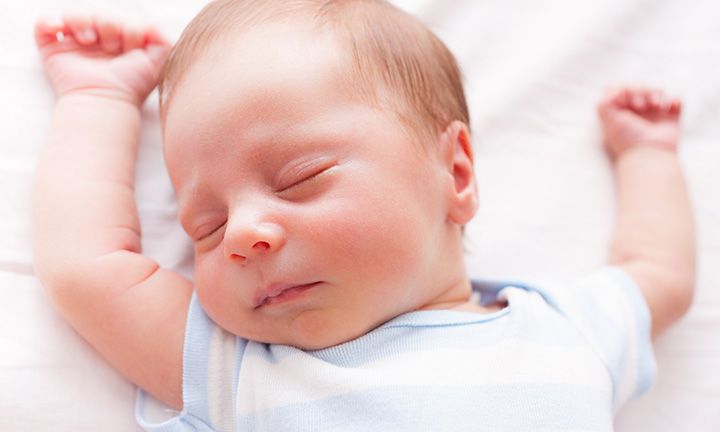
When to Introduce a Pacifier to Your Baby: Your Guide to Pacifiers
4 min readUpdated September 08, 2023
4 min readUpdated September 08, 2023
Babies have a natural instinct to suck, and pacifiers have long been used to soothe and comfort them. However, it’s natural to wonder when it’s appropriate to introduce a pacifier to your baby, whether it’s safe, and when an ideal time is for your little one to stop using a pacifier. Keep reading for the answers to these questions and helpful insights regarding pacifier use for your baby.
Do Babies Need Pacifiers?
Deciding whether to give your baby a pacifier is a personal choice that depends on your baby’s needs and preferences as well as your parenting style. If you’re wondering whether pacifiers are bad for babies, you’ll be reassured to know that using a pacifier can actually offer many benefits for little ones. These benefits may include:
What Are the Benefits of Not Using a Pacifier?
It’s natural to weigh the possible outcomes, both positive and negative, when it comes to giving your little one a pacifier. But at the end of the day, the decision is up to you. Some of the potential drawbacks of pacifiers include:
When to Introduce a Pacifier to Your Baby
If you’ve just welcomed a new baby into the world, you may be wondering, “Can I give my newborn a pacifier?” Newborns can use pacifiers at any time; however, if you’re breastfeeding, some experts recommended waiting until breastfeeding is well established, typically around 3 to 4 weeks (though this varies from baby to baby), before introducing a pacifier.
Pacifiers and Breastfeeding
As mentioned above, you may wish to wait until you and your newborn have settled into your nursing routine before introducing pacifiers to a breastfed baby. The concern is that pacifier use may disrupt breastfeeding by causing “nipple confusion” due to the different sucking mechanisms used in breastfeeding and pacifier use.
If you have any questions about breastfeeding and when to introduce a pacifier, check in with your baby’s healthcare provider or with a lactation consultant for personalized guidance.
Tips on Safety and When to Use a Pacifier
If you plan to offer your baby a pacifier, you may want to consider the following points and suggestions:
Can Babies and Newborns Sleep With a Pacifier?
Babies and newborns can safely sleep with a pacifier; in fact, sucking on a pacifier at nap time or bedtime may soothe your little one and help them fall asleep. Experts also believe that pacifiers may help reduce the risk of SIDS.
If your baby sleeps with a pacifier, they may wake in the night if it falls out. If they’re not old enough to put it back in their mouth themselves, you may need to help them if they cry out for you.
If the pacifier drops on the floor, clean it using the methods mentioned above, or give your baby a fresh one to use.
When “Should” Babies Stop Using Pacifiers?
How long should babies use pacifiers? Although there is no standard age range for pacifier use, professionals recommend discontinuing them once a child turns 1 year old. However, it’s not uncommon for children to still use pacifiers at an older age, then stop using them between 2 and 4 years of age.
If your little one is having difficulty letting go of their pacifier, gradually reduce the frequency and duration of pacifier use to help your baby transition away from it. Perhaps limit it to sleep time or when your little one needs comfort.
Use positive reinforcement, such as praise or small incentives, to encourage your child to give up the pacifier. Create a supportive environment during the transition process.
Remember, every child is different, and you should consider your child's individual needs and consult with their healthcare provider if you need guidance.
FAQS AT A GLANCE
If you choose to offer your newborn a pacifier, you can give it to them any time if they’re bottle-fed. But if you’re planning to breastfeed, it’s best to wait until they’re 3 to 4 weeks old to allow breastfeeding to become established first.
Babies have a natural need to suck, and giving them a pacifier between feedings or during sleep time may help soothe them and satisfy this need.
The Bottom Line
Offering a pacifier to your baby can provide comfort and soothing benefits and may help protect against SIDS (sudden infant death syndrome). However, it’s best to establish your breastfeeding routine first before introducing a pacifier. It's also wise to consider your little one’s preferences, prioritize safety, and eventually wean your child off pacifier use to reduce the risk of potential dental issues.
Remember that every child is unique, and it’s essential to adapt your approach to suit their individual needs. Consulting with your healthcare provider can offer personalized advice and guidance throughout this process.
- American Academy of Pediatrics, Caring for Your Baby and Young Child: Birth to Age 5, 7th ed. (New York: Bantam Books, 2019).
- Mayo Clinic. Guide to Your Baby’s First Years, 2nd ed. (Rochester, MN: Mayo Clinic Press, 2020).
- Healthy Children. “Pacifiers and Thumb Sucking.”
- Healthy Children. “Pacifiers: Satisfying Your Baby's Needs.”
- Mayo Clinic. “Infant development: Milestones from 7 to 9 months.”
- Mayo Clinic. “Pacifiers: Are They Good for Your Baby?”
- NCBI. “Pacifiers (soothers): A user’s guide for parents.”
- NCBI. “Pacifier use and breastfeeding in term and preterm newborns—a systematic review and meta-analysis.”
- NCBI. “Should breastfeeding babies be given pacifiers?”
Read more about Baby
Related Articles
Join a World of Support
through Pregnancy and Parenthood.
TRACK WITH TOOLS
LEARN WITH EXPERTS
GET REWARDED












